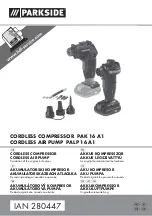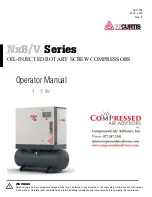
6
Parts & Service: 020 8988 7400 / E-mail: [email protected] or [email protected]
TO COMPRESS A SPRING REMOVED FROM A VEHICLE.
1. Measure the outside diameter of the spring to be compressed and select
the correct set of jaws to fit the spring.
2. Mount the selected jaws on the compressor body, using the retaining bolts
and tighten securely.
3. Rotate the hexagonal nut, to drive the jaws apart to the length of the
spring and to allow compression of as many windings as possible.
4. Place the spring compressor onto the spring, ensuring the spring seats
correctly between the safety lips and the outer ribs and cannot slide out
during compression.
5. Ensure the jaws and body are correctly aligned.
6. Rotate the hexagonal nut and compress the spring.
7. Secure the spring with a spring clamp or other suitable device.
TO DECOMPRESS A SPRING REMOVED FROM A VEHICLE.
1. To decompress the spring, reverse the compress procedure.
• Make sure you release the tension slowly to reduce the risk of the
spring slipping/flying out.
MAINTAINING THE SPRING COMPRESSOR
• Before each use check the compressor to ensure it is not damaged
or worn.
• If suspect, do not use the unit, but contact your local Clarke Dealer
who will be able to advise you regarding repair and spare parts.
• Grease the compressor spindle as necessary to inhibit corrosion.
• Keep the compressor clean, and when not in use, store in a safe,
dry, location.
WARNING: DO NOT COMPRESS THE SPRING TO AN EXTENT WHERE THE
COIL WINDINGS OR JAWS TOUCH.
WARNING: DO NOT USED AIR TOOLS.
CHT747.fm Page 6 Thursday, August 8, 2013 3:57 PM
Summary of Contents for CHT747
Page 8: ......


























